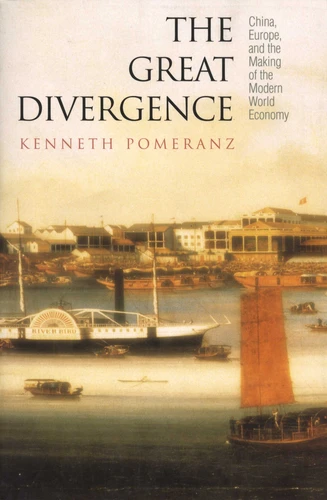The Great Divergence. China, Europe, and the Making of the Modern World Economy
Par :Formats :
Définitivement indisponible
Cet article ne peut plus être commandé sur notre site (ouvrage épuisé ou plus commercialisé). Il se peut néanmoins que l'éditeur imprime une nouvelle édition de cet ouvrage à l'avenir. Nous vous invitons donc à revenir périodiquement sur notre site.
- Paiement en ligne :
- Livraison à domicile ou en point Mondial Relay indisponible
- Retrait Click and Collect en magasin gratuit
- Réservation en ligne avec paiement en magasin :
- Indisponible pour réserver et payer en magasin
- Nombre de pages382
- PrésentationBroché
- FormatGrand Format
- Poids0.54 kg
- Dimensions15,6 cm × 23,5 cm × 2,3 cm
- ISBN0-691-09010-6
- EAN9780691090108
- Date de parution01/01/2000
- ÉditeurPrinceton University Press
Résumé
The Great Divergence brings new insight to one of the classic questions of history : Why did sustained industrial growth begin in Northwest Europe, despite surprising similarities between advanced areas of Europe and East Asia ? Kenneth Pomeranz shows, as recently as 1750, parallels between these two parts of the world in life expectancy, consumption, product and factor markets, the strategies of households, and perhaps most surprisingly, ecology.
Pomeranz argues that Europe's nineteenth-century divergence from the Old World owes much to the fortunate location of coal, which substituted for timber, and trade with the Americas. Together, coal and the New World allowed Europe to grow along resource-intensive, labor-saving paths. Meanwhile, Asia hit a cul-de-sac. Although the East Asian hinterlands boomed after 1750, both in population and in manufacturing, this growth prevented these peripheral regions from exporting vital resources to the cloth- Krproducing Yangzi Delta.
As a result, growth in the core of East Asia's economy essentially stopped, and what growth did exist was forced along labor-intensive, resource-saving paths—paths Europe could have been forced down, too, had i of been for favorable resource stock from underground and overseas.
Pomeranz argues that Europe's nineteenth-century divergence from the Old World owes much to the fortunate location of coal, which substituted for timber, and trade with the Americas. Together, coal and the New World allowed Europe to grow along resource-intensive, labor-saving paths. Meanwhile, Asia hit a cul-de-sac. Although the East Asian hinterlands boomed after 1750, both in population and in manufacturing, this growth prevented these peripheral regions from exporting vital resources to the cloth- Krproducing Yangzi Delta.
As a result, growth in the core of East Asia's economy essentially stopped, and what growth did exist was forced along labor-intensive, resource-saving paths—paths Europe could have been forced down, too, had i of been for favorable resource stock from underground and overseas.
The Great Divergence brings new insight to one of the classic questions of history : Why did sustained industrial growth begin in Northwest Europe, despite surprising similarities between advanced areas of Europe and East Asia ? Kenneth Pomeranz shows, as recently as 1750, parallels between these two parts of the world in life expectancy, consumption, product and factor markets, the strategies of households, and perhaps most surprisingly, ecology.
Pomeranz argues that Europe's nineteenth-century divergence from the Old World owes much to the fortunate location of coal, which substituted for timber, and trade with the Americas. Together, coal and the New World allowed Europe to grow along resource-intensive, labor-saving paths. Meanwhile, Asia hit a cul-de-sac. Although the East Asian hinterlands boomed after 1750, both in population and in manufacturing, this growth prevented these peripheral regions from exporting vital resources to the cloth- Krproducing Yangzi Delta.
As a result, growth in the core of East Asia's economy essentially stopped, and what growth did exist was forced along labor-intensive, resource-saving paths—paths Europe could have been forced down, too, had i of been for favorable resource stock from underground and overseas.
Pomeranz argues that Europe's nineteenth-century divergence from the Old World owes much to the fortunate location of coal, which substituted for timber, and trade with the Americas. Together, coal and the New World allowed Europe to grow along resource-intensive, labor-saving paths. Meanwhile, Asia hit a cul-de-sac. Although the East Asian hinterlands boomed after 1750, both in population and in manufacturing, this growth prevented these peripheral regions from exporting vital resources to the cloth- Krproducing Yangzi Delta.
As a result, growth in the core of East Asia's economy essentially stopped, and what growth did exist was forced along labor-intensive, resource-saving paths—paths Europe could have been forced down, too, had i of been for favorable resource stock from underground and overseas.





